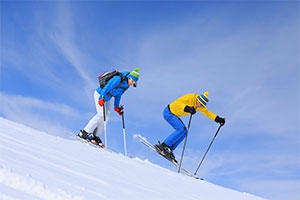Skiing and Knee Injuries

Skiing can lead to various knee injuries due to the dynamic and often high-impact nature of the sport. Some common knee injuries associated with skiing include:
- Anterior Cruciate Ligament: The ACL, one of the key ligaments that helps stabilize the knee joint, can be injured in skiing. This can occur due to sudden stops, changes in direction, or landing from a jump incorrectly.
- Medial Collateral Ligament: The MCL, another important ligament in the knee, can be injured when the skier experiences a force that pushes the knee inward (i.e. valgus force). This type of injury often occurs in skiing when the lower leg is pushed sideways, often by a fall or collision.
- Meniscal Tears: The meniscus, a C-shaped cartilage in the knee, can be torn if the knee joint is twisted while bearing weight. This kind of injury can happen in skiing during turns and twists, especially if the foot is still while the body continues to move.
- Patellar Tendonitis: Also known as "jumper's knee," this is an overuse injury affecting the tendon that connects the kneecap (patella) to the shinbone (tibia). It can occur in skiing from repetitive jumping and landing.
- Fractures: While less common, fractures can occur in skiing accidents. The most common is the tibial plateau fracture, where the top part of the shinbone near the knee is broken. This injury could require surgical fixation with plates and screws.
- Knee Sprains: These involve injury to the ligaments around the knee and can vary in severity.
- Dislocation: Although rare, the knee can dislocate in a high impact fall or collision. This can be a very serious injury and needs to be diagnoses quickly to make sure the nerves and artery are still intact.
What can you do to minimize skiing injuries?
Preventing skiing injuries involves a combination of proper preparation, equipment use, and technique.
Here are some key strategies to help reduce the risk of injury while skiing:
- Physical Fitness: Being in good physical shape is crucial. Engage in exercises that improve strength, flexibility, and endurance, focusing on muscles used in skiing such as the legs, core, and back.
- Proper Equipment:
- Skis: Choose skis appropriate for your skill level and the type of skiing you'll be doing.
- Bindings: Ensure they are correctly adjusted to your weight and skill level. Properly adjusted bindings can release in a fall, reducing the risk of leg injuries.
- Boots: Ski boots should fit well, providing support without being too tight.
- Helmet: Always wear a helmet to protect against head injuries.
- Warm-Up: Before hitting the slopes, do a proper warm-up to prepare your muscles and joints. This could include stretching, light jogging, or simple calisthenics.
- Skiing Technique:
- Take lessons from qualified instructors, especially if you are a beginner or returning after a long break.
- Learn how to fall correctly to minimize injury.
- Practice turns and stops on easier slopes before advancing.
- Awareness and Caution:
- Stay aware of your surroundings, including other skiers and obstacles.
- Ski within your ability level and don't attempt slopes or maneuvers that are beyond your skill set.
- Hydration and Nutrition: Stay hydrated and consume enough calories to maintain energy levels.
- Rest: Fatigue can lead to mistakes and injuries, so take breaks when needed.
- Follow the Rules: Adhere to the ski area's rules and guidelines, including designated areas and warning signs.
- Use of Protective Gear: Consider additional protective gear like wrist guards, knee pads, or a back protector, especially if you're doing more aggressive skiing.
- Weather and Snow Conditions: Be mindful of the weather and snow conditions, as they can significantly impact safety. Avoid skiing in extreme conditions.
- Avoid Alcohol and Drugs: Skiing under the influence impairs judgment and reaction times, increasing the risk of accidents.
Proper technique, equipment, and conditioning can help reduce the risk of these injuries. If you injured your knee while skiing, it is important to seek medical care.

- Have any questions:
check out
https://www.elyussif.com - Blog by Dr. Eddie El-Yussif Fellowship trained Knee Surgeon Board Certified Orthopedic Surgeon
Dr. Eddie El-Yussif is a Board-Certified Fellowship-Trained Orthopedic Surgeon and Fellow of the American Academy of Orthopaedic Surgeons specializing in Knee Surgery at Henry Ford Health, serving the greater Detroit area.


